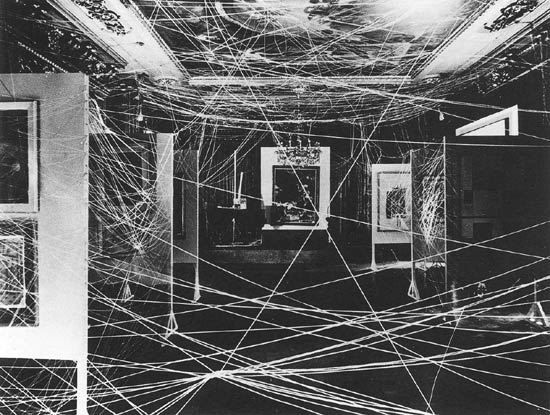Art Exhibition Practices in Avant-Garde and Contemporary Culture
By Nat Zingg
Disclaimer: Pardon the brief meta-analysis of Emergent Art Space, written for Emergent Art Space.
Emergent Art Space's description and mission lists the dual projects of providing (1) a website where young artists can exhibit a portfolio of their work; and (2) an “art space in San Francisco, which will pursue the same goals” as the website in a 'physical' gallery. In enumerating these projects (1) and (2), I might be presuming to separate the 'website' and the San Francisco 'art space' into two distinct endeavors, but as I see it, EAS's mission could also be figured as the development of an interrelated exhibition space, situated in and in-between the 'physical' and the 'virtual.' Following this presupposition, I would like to consider a couple of examples from avant-garde and contemporary art that share EAS's vision for a broader art 'space' that moves between 'physical' and 'virtual' presentation modes.
Long before the invention of the internet, Marcel Duchamp created an ambitious installation that transformed a New York gallery space into (what could be viewed as) a web of inter-connected artworks. As referenced in the coda to Linda Henderson's Duchamp in Context (215-6, 315n), Duchamp's “Sixteen Miles of String” is a “labyrinthine” work.A photo of the famous installation shows that a complex crisscrossing of thin, barely visible string spans the ceiling, the floor and the various picture-frames throughout the gallery. The implications of Duchamp's conceptual work for André Breton's 1942 exhibition “Papers of Surrealism” are interesting to consider in light of contemporary modes of 'virtual' art-exhibition. On the one hand, as has been suggested, Duchamp's network of string prohibits the viewer from 'physically' entering spaces via certain pathways: it looks as if entry to the Mondrian on the right might be hindered by an intricate web of string. But on the other hand, the string suggests other (and multiple) possibilities of connection between the displayed works of art. Beyond walking through the space, Duchamp's string imagines a complex passage through the gallery across a web of linkages.
If Duchamp's spider-web of modernist art could be a seen as a preliminary mock-up of a 'physical' gallery made 'virtual,' the internet has made this kind of exhibition practice commonplace. Most major museums have a heavy web presence, often presenting digital copies of their major works online, and/or allowing for virtual walkthroughs of their most important 'physical' spaces. The hyperlink makes Duchamp's connections of string the norm. Like the surrealist exhibition's latticework, for these museums, the web serves as an added element to the 'physical' art space—another means of entry into the collection. However, the gambit of Emergent Art Space seems to reverse these processes: here, we have a collection that began on the internet, and all of its 'physical' instantiations in space might be seen as representations of its 'virtual' original. Similar to SFMOMA, which will now be living without a 'physical' museum for two years, Emergent Art Space has existed for most of us on the web primarily—and its physical instances are extensions of this internet presence. Perhaps EAS, in its predominant virtuality, approximates more closely the Duchampian network of art.
Nat Zingg is a comparative literature graduate student at the University of Texas at Austin. Some of his interests are historical avant-garde movements in Europe and Latin America, surrealism and film studies.
